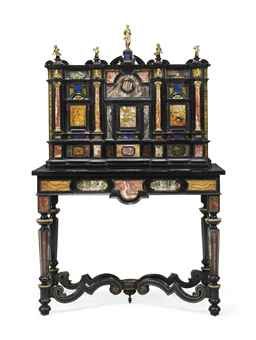An Italian ormolu-mounted, specimen hardston, tortoiseshell and ebony cabinet-on-stand. circa 1700, probably Florence
An Italian ormolu-mounted, specimen hardston, tortoiseshell and ebony cabinet-on-stand. circa 1700, probably Florence, embellished circa 1860 when the stand was constructed. Photo: Christie's Images Ltd., 2011
Pewter-strung throughout, the pediment with central female figure flanked by putti above an architectural facade, with eight drawers and three concealed internal drawers, inlaid with specimen stones including diaspri di Sicilia, jaspé du Mont Blanc, rouge griotte, alabastro fiorito, flame agate and lapiz lazuli, the stand with central frieze drawer on turned faceted tapering legs joined by an X-stretcher, the drawers to the cabinet numbered in pencil, restorations
The cabinet: 34½ in. (88 cm.) high; 40 in. (102 cm.) wide; 16 in. (41 cm.) deep
The stand: 33 in. (84 cm.) high; 44 in. (112 cm.) wide; 21¼ in. (54 cm.) deep
Estimate £25,000 - £40,000 ($39,875 - $63,800)
Provenance: The Marquesses of Bute, by repute.
Notes: Florence became a centre for the production of hardstone-mounted cabinets following the foundation of the Opificio delle pietre dure, in 1588 by Grand Duke Ferdinand I de Medici. By the mid-17th century there was a significant demand for the production of splendid and elaborate cabinets such as the present lot. These often adopted an architectural form, the ebony frame providing the perfect foil for the expensive specimen hardstones and ormolu mounts favoured by a growing population of wealthy patrons. This cabinet was restored and embellished in the 19th Century when such objects were once again highly sought-after and were often purchased by wealthy noblemen on the Grand Tour.
Whilst there is nothing more substantive than tradition to link this cabinet to the Bute collections, John Patrick Crichton-Stuart, 3rd Marquess of Bute, is known to have had a passion for marbles; he often incorporated interesting and diverse specimens into his various substantial building projects, including the staircase at Mount Stuart on the Isle of Bute. In 1887 he instructed his agent P.E. Rainford Esq., the British Vice-Consul in Messina, Sicily, to purchase on his behalf a substantial and elaborate specimen stone and ormolu tabernacle and to arrange for its shipping back to England (Works of Art from the Bute Collection, sold Christie's London, 3 July 1996, lot 8). It is therefore reasonable to presume that Rainford may have purchased other items such as the present cabinet on the Marquess' behalf to furnish the great houses he was building at Cardiff and Mount Stuart.
Christie's. From the distinguished decorator's houses in Madrid and Trujillo, Spain,, 20 - 21 July 2011, London, South Kensington www..christies.com

/https%3A%2F%2Fprofilepics.canalblog.com%2Fprofilepics%2F1%2F0%2F100183.jpg)



/http%3A%2F%2Fstorage.canalblog.com%2F88%2F93%2F119589%2F65180143_p.jpg)
/http%3A%2F%2Fstorage.canalblog.com%2F08%2F76%2F119589%2F62845690_p.jpg)
/http%3A%2F%2Fstorage.canalblog.com%2F55%2F06%2F119589%2F60675493_p.jpg)
/http%3A%2F%2Fstorage.canalblog.com%2F51%2F83%2F119589%2F59771294_p.jpg)